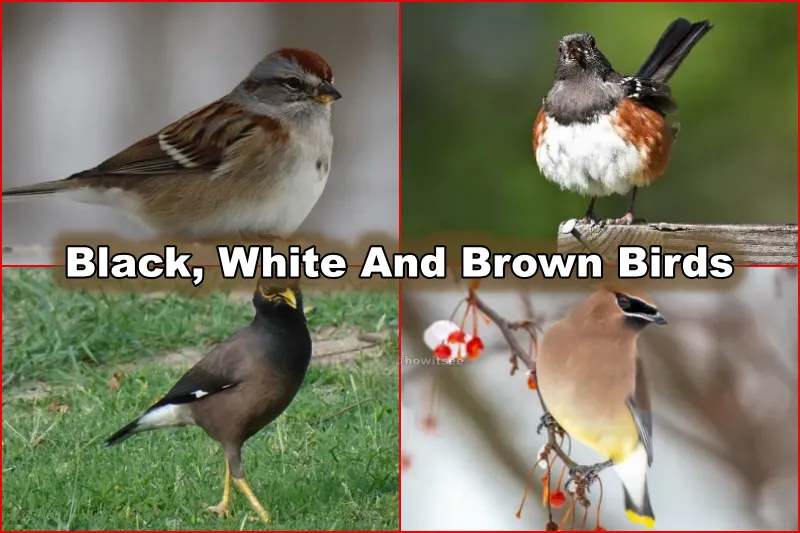Identifying the many kinds of birds is a crucial part of the sport of bird watching, enjoyed by many nature lovers. Black, white, and brown are hues shared by numerous bird species, making it difficult to tell them apart.
One may, however, learn to reliably identify these Black, White, And Brown birds via close study and familiarity with the unique traits of each species.
This article aims to help readers learn to recognize common black, white, and brown birds and, by extension, to grow in admiration for all birds.
Common black, white, and brown birds found in North America, Europe, and other regions will be discussed. We’ll look at what these birds look like, where they live, and how they act to determine their species. So let us dive in now!
Where do Black, White, And Brown Birds live?
Seeing black, white, and brown birds in the wild and populated areas is possible.
- Common forest birds include woodpeckers, wood warblers, thrushes, and vireos. The brown creeper and the barred owl are harder to see in the forest, but the black-capped chickadee, nuthatch, and titmouse are easy to detect.
- Grasslands provide various wildlife habitats, including meadowlarks, bobolinks, horned larks, and Killdeers. These birds use the tall grasses as a refuge from predators, a place to nest, and a source of food (seeds and insects).
- Many bird species, such as ducks, geese, herons, grebes, and rails, are dependent on wetland habitats for their existence. These birds cannot survive without the marshland environment.
- Countless brown and black bird species call deserts home, such as quail, roadrunners, sparrows, and cactus wrens. These birds can survive in the harsh conditions of the desert and frequently have to beg for food.
- Species of birds that are in steep decline elsewhere are finding urban settings to be an increasingly vital refuge. Urban parks, backyards, and other green spaces are frequent haunts for several black and brown bird species, including pigeons, crows, and starlings.
Black birds, white birds, and brown birds all play important roles in ecosystems all around the world. Therefore, it is of the utmost importance to provide them with suitable shelter and to safeguard their natural environments.
It helps regulate insect populations, spreads seeds and pollinates flowers, all of which are good for the ecosystem.
Common Black, White, And Brown Birds
1. Common Myna
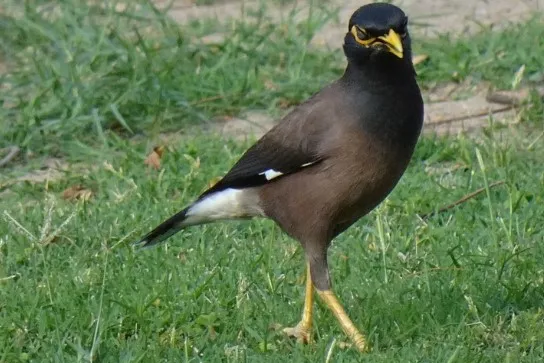
| Scientific Name | Acridotheres tristis |
| Size | 23 cm |
| Life Span | 4-6 years |
| Location | Asia |
| Price | $500-$1,000 |
Medium-sized starling with a striking brown body, black head, and yellow spots behind the eyes, the common myna is also known as the Indian myna.
In addition to having white wing patches and linings, this bird has brilliant yellow bills and legs. It’s not easy to distinguish men from women since they appear similar.
Although native to Asia, this species has been successfully introduced to many other regions across the globe. Its population has exploded over the last two decades, making it one of the deadliest invasive species on the planet.
Although they prefer wooded areas, you may also see them in suburban and urban areas. This species is problematic because it clogs up rain gutters and downspouts, resulting in costly water damage to urban structures.
2. Brown Shrikes
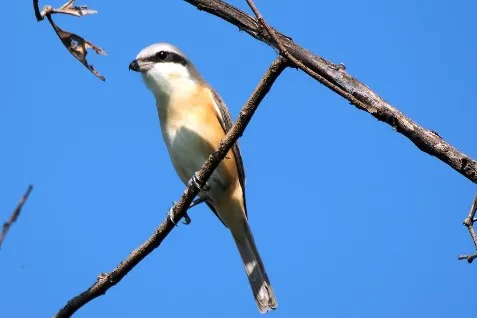
| Scientific Name | Lanius cristatus |
| Size | 18-20 cm |
| Life Span | 2-3 years |
| Location | Asia |
| Price | No Fixed Price |
Brown shrikes, sometimes known as “butcher birds,” are a species of passerine bird native to Asia. They have brown bodies and heads with rufous colored bellies and a black bandit-like mask running between their eyes. The females’ brown covers are less distinct than the males’.
They are infrequent visitors to Europe, the United States, and Canada, although they breed in northern Asia and spend the winter in southern Asia.
They prefer open scrubland settings, where they may be seen perched on thorny shrubs during the mating season. In the winter, they always return to the same place, usually a warmer climate. They impale them on thorns while perched high in the trees to kill their insect meal.
3. American Tree Sparrow
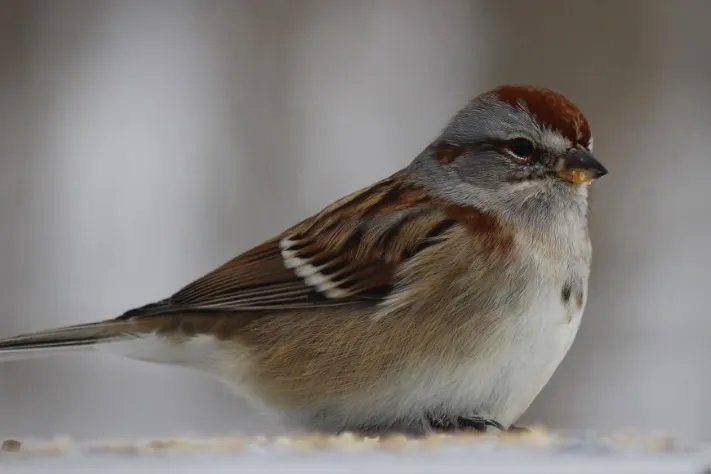
| Scientific Name | Spizella arborea |
| Size | 14-15 cm |
| Life Span | 2-3 years |
| Location | Canada and Alaska |
| Price | No Fixed Price |
Migratory tree sparrows nest in Alaskan and Canadian boreal woods or on the tundra. They spend the winter in the southern United States and Canada.
They are familiar visitors at winter feeders due to their attractive appearance and habit of foraging on the ground or in low shrubs for food (seeds, insects, and berries).
Feeding millet, cracked corn, and sunflower seeds based on or in low-platform feeders is the best approach to attracting an American tree sparrow.
4. Chestnut-collared longspur
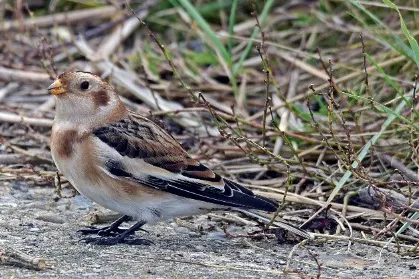
| Scientific Name | Calcarius ornatus |
| Size | Approx 14 cm |
| Life Span | 2-3 years |
| Location | Great Plains of North |
| Price | Not Sold |
These birds are distinguished by their small, conical bills, iridescent backs, and whitetails with black tips.
The male has a black underside, chestnut back, yellow neck, and black cap in breeding plumage. Some other birds have chestnuts on their napes and crowns, brown wings, and lighter brown underparts.
5. Smith’s Longspur
| Scientific Name | Calcarius pictus |
| Size | 13-16 cm |
| Life Span | Around 6 years |
| Location | North America |
| Price | No Fixed Price |
The Smith’s longspur is a ground-dwelling bird native to North America, distinguished by its pronounced spotting of grey, brown, and white over its back.
Male adults are distinguished from females by their black and white faces and orange throats, napes, and underparts. Females and young birds have less pronounced striping, buffy undersides, and pale cheeks.
This species prefers farmland and grassland over residential yards. They set up their nests in grassy clearings close to the forest boundaries of Northern Canada and Alaska.
They gather in immense flocks in the southern United States throughout the winter. They often fly south across the Great Plains in the late autumn. The Smith’s longspur is primarily a seed feeder. However, it may consume insects when available.
6. Brown Jay
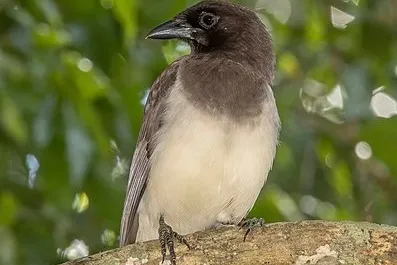
| Scientific Name | Psilorhinus morio |
| Size | 25-30 cm |
| Life Span | Around 10 years in captivity |
| Location | Mexico, Central America, and Northern South America |
| Price | No Fixed Price |
There are two significant groups of brown jays that their different plumage may distinguish. Birds in the north are primarily dark brown overall, with lighter brown feathers on the underside.
The birds of the south have white bellies, and the outer tail feathers are tipped in dazzling white. Veracruz, Mexico, is home to the intergrade zone.
Adults in both groups have all-black limbs and appendages. The eye rings, and other exposed areas of an immature are also yellow.
The pee-ah sound is loud yet low in pitch, and the animal will alter its tone according to the circumstances or mood.
7. Brown Thrasher
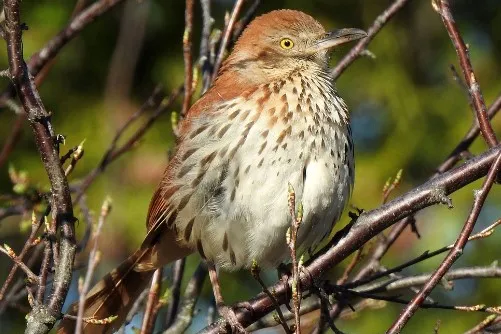
| Scientific Name | Toxostoma rufum |
| Size | 23-33 cm |
| Life Span | 3-6 years |
| Location | United States and Southern Canada |
| Price | No Fixed Price |
A New World member of the mockingbird family, the brown thrasher is sometimes known as a brown thrush. These birds have a reddish-brown upper body and a buff underside; their chests are marked with black teardrops.
Long, rounded bills that bend downward characterize this species. The only distinguishing feature between adults and youngsters is the texture of their plumage, and males and females seem identical.
The eastern and central United States and the southern and central parts of Canada are home to brown thrashers. They may be found in various environments, from forest peripheries and thickets to farmland and residential backyards.
However, unlike most other species, they avoid residential areas. However, planting thick bushes and fruit-bearing trees may attract these creatures to your yard.
8. Brown Pelican
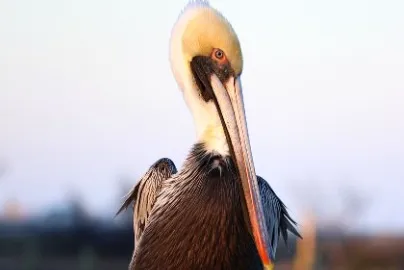
| Scientific Name | Pelecanus occidentalis |
| Size | 180-202 cm |
| Life Span | 25 years |
| Location | Atlantic and Pacific coasts of North and South America |
| Price | No Fixed Price |
In breeding plumage, the nominate subspecies have a white head and a gold wash on the crown. The nape’s central feathers are lengthy, extending into a short, dense chestnut crest.
The nape and neck are a deep, wine-colored brown. White lines may be seen on the upper neck near the gular pouch and a light yellowish patch on the lower foredeck.
The bird’s silvery grey mantle, scapulars, and upper wing coverts may appear brownish. Since the smaller coverts’ bases are black, the wing’s leading edge appears streaked. Silvery white streaks appear in the middle of the upper-tail coverts (feathers above the tail).
9. Black-capped Chickadee
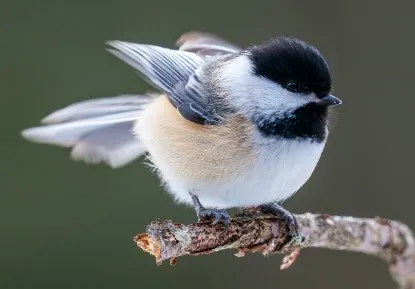
| Scientific Name | Poecile atricapillus |
| Size | 11-16 cm |
| Life Span | 2-3 years |
| Location | North America, including Canada, the United States, and Mexico. |
| Price | No Fixed Price |
The black-capped chickadee is easily identified by its black crown, “bib,” and white cheeks and chin. Its typical coloration is a gray back and a gray tail. It has white bellies and reddish-brown flanks.
The black-capped chickadee is similar to the Carolina chickadee in appearance, but their ranges are somewhat different. Although the black-capped is often bigger, size alone is not diagnostic.
The two species’ distinction is easy to make by their wing feathers. The black-capped chickadee’s white wing margins are more prominent than the Carolina chickadee.
10. White-throated sparrow
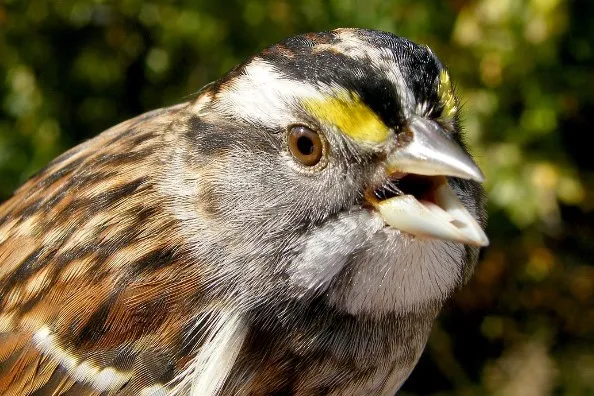
| Scientific Name | Zonotrichia albicollis |
| Size | 16 cm |
| Life Span | 2-3 years |
| Location | North America |
| Price | Not known |
White throat patterns and vivid yellow lores distinguish them from the white-crowned sparrow. Tan-striped and white-striped mature plumage exist.
The white-striped crown is black with a white stripe. Gray auriculars with black tops. White supercilium.
Both subspecies have black eyes, white necks, golden lores, and gray bills. Tan variants have dark brown crowns with tan lines.
Tan supercilium hair tops the head. The auriculars have a dark brown ring and a light gray or brown base. Black stripes on both sides of their channels show individuality.
11. White-crowned sparrow
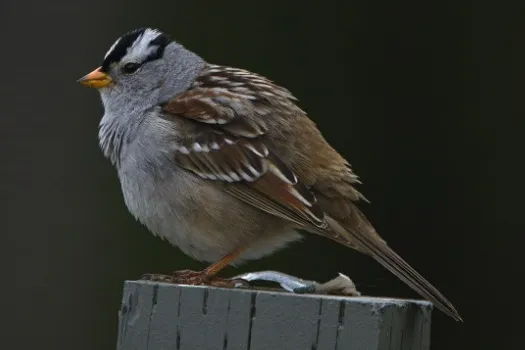
| Scientific Name | Zonotrichia leucophrys |
| Size | 15-18 cm |
| Life Span | 2-3 years |
| Location | North America from Alaska to Mexico |
| Price | Not Applicable |
The adult has a long tail, brown spots on its upper body, a grey face, and black and white stripes on its head. Furthermore, the upper sections are grey, while the lower parts are brown with bars.
Additionally, it has a pink or yellow bill. Although they resemble the white-throated sparrow, they lack that species‘ identifying white neck markings and bright yellow lores.
12. Eastern towhee
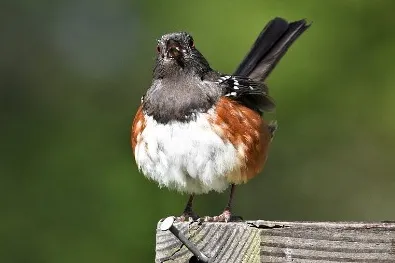
| Scientific Name | Pipilo erythrophthalmus |
| Size | 19-22 cm |
| Life Span | 2-3 years |
| Location | North America |
| Price | Not known |
Adults are distinguished by their rufous backs, white bellies, and long black tails with white tips. Southeast Asian birds have white eyes instead of the typical red.
The males have black on their heads, backs, and seats, while the females have brown. In general, kids are brown. Eastern towhees of both sexes and all ages are easily distinguished from the similar western spotted towhee, and the two species are not thought to coexist.
13. Brown Creeper
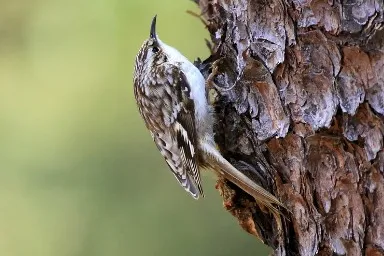
| Scientific Name | Certhia americana |
| Size | 11-13 cm |
| Life Span | 4-6years |
| Location | North America from Alaska and Canada to southern parts of Mexico |
| Price | No Price |
The brown creeper, or American treecreeper, is a tiny songbird with a distinctive camouflage pattern resembling many tree species’ bark.
Their upper bodies are pale to medium brown with occasional white spots, while their underbellies are pure white. They utilize their long, thin bills and tails as climbing aids, and their seats are lengthy and rigid.
The treecreeper was originally from North America, where it established permanent residence. Northern populations migrate south during the winter from their breeding grounds in coniferous forests in Canada, Alaska, and the northeastern and western United States.
Strays have been seen as far south as Guatemala, Bermuda, Honduras, and El Salvador. Suet, peanut butter, sunflower seeds, and pine nuts are all effective winter foods for luring brown creepers into your yard.
14. Cedar Waxwing
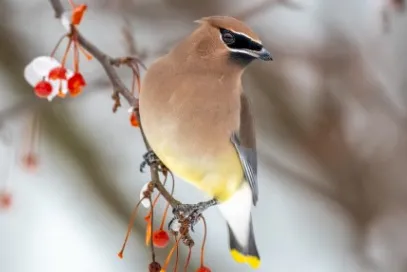
| Scientific Name | Bombycilla cedrorum |
| Size | 15-18 cm |
| Life Span | 5-6 years |
| Location | North America, ranging from southern Canada to the southern United States and Mexico. |
| Price | Not known |
Cedar waxwings are medium-sized birds with wingtips that look like wax, thus the name. Their feathers are a glossy mix of brown, grey, and yellow, with white linings, vivid red wax drops, and a black face mask for accent. Their large, short bills and short, square-tipped tails set them apart.
During the spring and summer, black-capped chickadees can be found in southern Canada, while in the winter, they migrate to the south of the United States, Mexico, and Central America.
Edges of forests and woods near water and berry bushes are ideal locations to find these animals. Beautiful cedar waxwings might be attracted to your yard by planting a variety of fruit trees and berry bushes.
Conclusion
Last but not least, learning to identify the many colors of birds may be a fascinating adventure. Birds come in every color on Earth, from black and white to brown and every shade in between.
Color is generally the first thing people notice when trying to identify a bird, but other traits, such as the shape of the beak, the wings, and the bird’s behavior, may help narrow down the possibilities.
By paying careful attention to these details and using appropriate field guides and resources, birdwatchers may learn to identify and appreciate the diversity of birds in their area and beyond.
We conclude our article on “Black, White And Brown Birds: How to Identify this Type of Bird.” We hope you like our post. We will be back with another exciting article. Till then, stay tuned with us.
References:
- Wikipedia
- Black and White Birds by Birdadvisors.com
- 12 Types of Brown Birds by AZanimals
- Different Types Of Black and White Birds by Birdzilla.com
Also Read:

A writer who studied agriculture. Nature has always drawn me in, and my main goal in writing about it is to discover some of its secrets. You can usually find me reading Bengali and English masterpieces or filling the room with lovely music if I’m not engrossed in nature or anime material. I adore playing the guitar. I’m also that friend of yours who enjoys playing video games.
